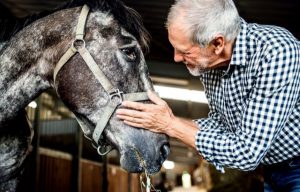A survey of over 2,700 owners of aged horses found that 79% were either fully or semi-retired and engaged in little structured exercise.* While retirement seems like a kind gesture, studies in human medicine show that continued physical activity and fitness provide many health benefits. The advantages of structured exercise in elderly humans include a reduction in age-related loss of muscle mass, strength, and function, which can lead to decreased disability and mortality.
Given this information, horse owners may question whether retirement without structured exercise is advisable for senior horses.
In the survey, 17% of owners reported their horses, all of which had to be 15 years old or older to be included in the study, had low muscle mass. Owners believed this loss of muscling affected their horses’ ability to work, rise after lying down, interact with other horses, and walk in the pasture.
“Notably, retired and semi-retired horses had higher odds of having low muscle mass than horses used for competition or pleasure,” said Catherine Whitehouse, M.S., of Kentucky Equine Research.
In turn, age, osteoarthritis, pituitary pars intermedia dysfunction (PPID, equine Cushing’s disease), and laminitis were all significantly associated with the odds of having low muscle mass.
“Elucidating the types of health problems leading to retirement would be beneficial, as this information could be used to develop prevention strategies that may permit extending a horse’s work/active life. A prolonged work/active life is also likely to provide health and welfare benefits to the horse. In elderly people, a myriad of exercise-associated health benefits have been described, and structured exercise might therefore similarly help preserve and improve overall health in senior horses,” wrote the survey authors.
This survey only superficially addressed reasons for retirement, reporting that poor health of either the horse or owner was a common motivation for retirement. Diagnosis of laminitis, lameness, and degenerative suspensory ligament desmitis by veterinarians were also identified as reasons for retirement.
According to the survey, owners should routinely monitor their horses’ muscle mass and, if appropriate, contact their veterinarian or nutritionist to formulate appropriate exercise programs or special diets.
“One tool to help owners assess muscling is MASS, a four-point scale that considers four regions of the horse—neck, back, abdomen, and hindquarters (pelvis and hind limb). The scoring scale ranges from 1 (no atrophy) to 4 (severe atrophy).** This system is much like the nine-point Henneke body condition score system,” Whitehouse explained.
Before a structured exercise program is incorporated into a senior horse’s life, a thorough health assessment should be performed by a veterinarian. The presence of laminitis may preclude certain types of exercise, and discomfort stemming from osteoarthritis should be addressed and appropriately managed.
“When structured exercise is not possible, maximizing voluntary exercise through turnout management helps reduce stiffness after being stalled and maintains muscle mass and strength. Dietary considerations to help manage decreases in muscle mass include offering a balanced diet that provides calories in an easily chewed and digested form, high-quality protein for essential amino acids, and supplementation with nutrients such as vitamin E and omega-3 fatty acids,” advised Whitehouse.
*Herbst, A.C., M.C. Coleman, E.L. Macon, A. Brokman, A.J. Stromberg, P.A. Harris, and A.A. Adams. Retirement risk factors, exercise management and muscle mass in US senior horses. Equine Veterinary Journal:13958.
**Herbst, A.C., M.G. Johnson, H. Gammons, S.E. Reedy, K.L. Urschel, P.A. Harris, and A.A. Adams. 2022. Development and evaluation of a muscle atrophy scoring system (MASS) for horses. Journal of Equine Veterinary Science:103771.











